| |
|
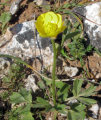 | |
| MaltaWildPlants.com by Stephen Mifsud |

|
| |
|
|
 |  |  |  |
| External Links: |
|
Heliotropium europaeum (Common Heliotrope) |
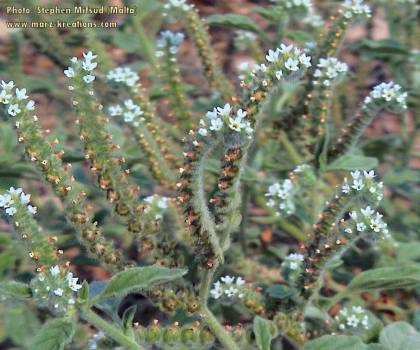
Heliotropium europaeum (BORAGINACEAE.)
Images for this profile are taken from the Maltese Islands after year 2000. |
|
| Nomenclature |
Species name : | Heliotropium europaeum L. | Authority : | Carl von Linne, Sweden, (1707 - 1778) | Synonyms :
(basionym or principal syn.) |
|
Plant Family : | | English name(s) : | Common Heliotrope, Potato weed, European Heliotrope | Maltese name(s) : | Vanilja bajda | Status for Malta : | Indigenous. Present on the Maltese islands before man | Name Derivation : |
Heliotropium: Helios- meaning the sun and -tropium meaning turning towards, with reference to the characteristic of many plants facing quickly towards the sun. (Greek origin ); 2 = "Helios" means sun, and "trope" means turning to, thus giving the meaning of turning to the sun. The name either refers to the summer solstice when the first described species had bloomed, or refers to the turning of flowers toward the sun, a characteristic known as heliotropism (Greek);.
europaeum: originating from or related to the continent of Europe. (Latin origin ); 2 = from Europe or related to the European continent (Latin).
| Remarks : | |
|
| Morphology and structure |
PLANT STRUCTURE: |
Character | Growth Form | Branching | Surface |
Description | | | |
General
Picture |  |  | 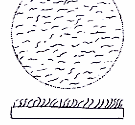 |
|
LEAVES: |
Character | Arrangement | Attachment | Venation |
Description | | | |
General
Picture |  | 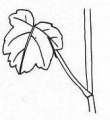 |  |
| |
Character | Leaf Shape | Leaf Margin | Remarks |
Description | | | |
General
Picture |  |  |  |
|
FLOWERS: |
Character | Colour | Basic Flower Type | No. of Petals | No. of Sepals |
Description | White | | 5 | 5 |
General
Picture | | 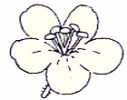 |  |  |
| |
Character | Inflorescence | Description | Ovary | Stamens |
Description | | The flowers are situated nearly at the tip of the coiled part of flowering stem (spike). There are about 3 to 6 tiny flowers open per every spike arranged in paired rows. Every flower is white with a yellow throat and consists of 5 petals forming the shape of a star. At the center there are 5 stamens fused to the inside of the corolla and a central pistil which are barely visible with the naked eye. | | |
General
Picture |  |  | 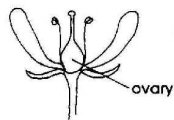 | 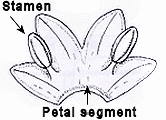 |
| |
Character | Scent | Average Flower Size | Pollen Colour | Other Notes |
Description | YES A fairly unpleasant smell. | 2-3mm | Pale yellow Anthers are hidden inside the neck-tube of the tiny flowers. | - |
|
SEEDS: |
Character | No. Per Fruit | Shape | Size | Colour |
Description | 4 | Tooth shaped Cylindrical with one end flat and attached in sockets in the receptacle and the apical end being rounded or pointed. | 1mm | Dark green They fall from the plant when they are still green, but they may get brown when they dry on the ground. |
General
Picture |  |  |  |  |
|
FRUIT AND OTHER BOTANICAL DATA: |
Character | Fruit Type | Colour of Fruit | Subterranean Parts | Other Notes |
Description | | Dark Brown | | - |
General
Picture |  |  |  |  |
|
|
| Plant description and characters | |
Life Cycle: | Annual. |
Growth Form: | THEROPHYTE (annual plants, herbaceous) |
Habitat: | Uncropped fields, waste ground near arable land and sometimes waysides. |
Frequency: | Common |
Localities in Malta: | Very Common in post-harvested fields throughout Malta and Gozo during summer such as at Qrendi, Zebbug, Qormi, Rabat, Ghajn Tuffieha and most of Gozo. |
Plant Height: | 20-50cm. |
| Jun-Sep |
Protection in Malta: | Not legally protected till the last update of this website (2/Mar/2022) |
Red List 1989: | Not listed in the Red Data Book of the Maltese Islands |
Poison: | |
The Heliotropium europaeum, is a well branching, erect, annual plant that shows it self in Summer. The plant is covered by numerous tiny, white bristles, mosty found at the stem and flowering parts, that makes It has a silvery-green colour and a slight coarse feeling on rubbing.
 The leaves are also covered with few bristles, but these feels soft.. The young leaves have an ovoid shape, while the adult, basal ones get a bit longer and so assume a linear-ovoid shape. Leaves have a smooth outline and show pinnate venations (more prominent at underside). Leaves measure about 25-30mm long and are attached to stem by a relatively long stalk (15-20mm long).
The leaves are also covered with few bristles, but these feels soft.. The young leaves have an ovoid shape, while the adult, basal ones get a bit longer and so assume a linear-ovoid shape. Leaves have a smooth outline and show pinnate venations (more prominent at underside). Leaves measure about 25-30mm long and are attached to stem by a relatively long stalk (15-20mm long).
The flowers are sessile and are arranged in a zigzag alternate pairs on a bractless spike that is coiled at the tip and unwinds while growing up. The length of spikes vary from 10mm when young up to 150mm. They look like a green caterpillar and hence one of the common names referred to this plant - "caterpillar weed". The fruit are found well spaced from each other further down the spike, while at the tip, there are the flowers which are more closely packed to each other. The open flowers (3 to 8 per spike) are found at the coiled tip of the spike, whereas the tip contain buds and developing flowers.
Each flower is up to 3mm across, have five white petals in the shape of a star with a yellow throat that is green at the very centre. The flower is so small that the female and male reproductive organs are not visible with the naked eye. However each of the tiny flower consists of 5 stamens, joined with the inner wall of the corolla, and a central green pistil. The flower parts lies above a larger ovary enclosed by 5 free, hairy sepals. The sepals also grasps and holds tight the developing fruit which consists of a group of 4 nutlets. When the nutlets ripen, the sepals gets more loose and the seeds drops to the ground bwithout any special means of disperssion.
The seeds are pear shaped, about 2mm long, and are clustered in tetrads(fours) - together making a flattened spherical structure collectively referred to a the fruit of the plant. The seeds are not hairy, about 1-2mm in size and when ripe they have a dark green colour. However they normally drop off to the ground pre-maturily and further ripens on the ground and becomes black in colour.
|
|
| Information, uses and other details |
General Information
H. europaeum is a native of southern and central Europe, western Asia and northern Africa. It was introduced accidentally to South Australia during the 19th century and was first collected in 1880. [WWW-22]
It is not an aggressive plant and is susceptible to competition. Its presence is therefore usually a clear indication of a prior history of cropping or overgrazing. The plant is rarely found where perennial grasses still occur. Common heliotrope is of considerable economic importance because it is toxic to sheep, cattle and horses [WWW-22]
Growth
Seeds germinate at any time during late spring and summer provided moisture is available. Aerial growth is slow at first, while the long taproot develops. This enables the young seedling to withstand dry periods even shortly after emergence. Given adequate moisture, growth continues throughout summer and autumn. [WWW-22]
Poisonous Properties
H. europaeum is an annual summer-growing herb that contains hepatotoxic pyrrolizidine alkaloids. [283]. It has caused poisoning of calves when the plant was ingested from contaminated straw bedding [284] and of pigs and poultry when its seeds contaminated stock feed. [285].
It is known that Heliotropium europaeum (q.v.) may be fatal to sheep and cattle that eat it. They get a disease called the 'yellows,' enzootic jaundice or hemolytic jaundice, which is a result of copper toxicosis. Liver tissue damaged by the plant's hepatotoxic alkaloids (e.g. heliotrine and lasiocarpine) causes the parenchyma cells to irreversibly enlarge (megalocytes), accumulate copper, die early and not be replaced. The liver may accumulate copper at a level of over 1000 ppm (dry, fat-free basis). [286, 287]
Most cases of pyrrolizidine alkaloid toxicity result in moderate to severe liver damage. Gastrointestinal symptoms are usually the first sign of intoxication, and consist predominantly of abdominal pain with vomiting and the development of ascites. Death may ensue from 2 weeks to more than 2 years after poisoning, but patients may recover almost completely if the alkaloid intake is discontinued and the liver damage has not been too severe. [WWW-23]
Most alkaloids are amino acid derivatives, and have no certain role in plant metabolism except for serving to repel insects and herbivore predators due to their bitter taste. Pyrrilozidine alkaloids are very common in plants used in livestock feeds and in rangeland weeds such as tansy ragwort, Senecio jacobea, and Heliotropium spp. and Crotolaria spp..
Pyrrolozidine alkaloids contain nitrogen in a heterocyclic ring forming a definite structure called the pyrrolizidine nucleus. It appears that the pyrrilozine alkaloids themselves are not toxic, rather, some of their metabolites, primarily their "pyrrolic" derivatives are highly toxic. Toxic alcohols can also be produced as secondary metabolites. The common PAs, Heliotrine and lasciocarpine, are partially reduced to the non-toxic 1-methylene and 7-hydroxy-1 methyl derivatives in the rumen. However, these can be activated by oxidases in the animal's liver to pyrrolic derivatives and thus have pathological effects in the heart, liver, kidney and respiratory system. The basis for alkaloid regulation and its effects in the ruminal ecosystem are not yet fully understood, but is a well-known fact that its degradation is directly proportional to its concentration in the rumen. Heliotrine degrading bacteria have been isolated and identified in the rumen. Although these bacteria appear to get very little useful energy from the cleavage of heliotrine, this characteristic may well improve their ability to successfully compete in the rumen of an animal exposed to this type of alkaloid. [WWW-24]
A document from the World Health Organization (Geneva 1989) [WWW-25]states that the contamination of cereal grains with seeds of Pyrrolizidine Alkaloids-containing plants has caused epidemics of human poisoning in four countries. The plants involved were species of Heliotropium, Trichodesma, Crotalaria, and Senecio. Another important form of exposure is the use of PA-containing herbs as medicines, food, or beverages; this has resulted in occasional cases of human poisoning. The most important of such PA-containing plants are species of Heliotropium, Crotalaria, Senecio, and Symphytum. Symphytum species (comfrey) are also available in the form of ointments or as digestive aids in the form of capsules.
Low-level exposure may occur in some countries through the presence of PAs in foods, such as honey and milk, but no reports of human poisoning caused through these media are available.
There are many interesting documents about pyrrolizidine alkaloid poisoning, and the most important can be found in the Links section at the bottom of this page.
Medicinal Properties
Since of its poisonous properties, this plant does not have much medicinal or edible uses. However HYPPA [WWW-21] describes this plant with the following properties:
| Desiccative |
able to promote dryness by absorbing moisture [WWW-06] |
| Resolutive |
serving to dissolve or relax [WWW-06] |
| Detergent |
a cleansing substance that acts similarly to soap but is made from chemical compounds rather than fats and lye (alkalis) [WWW-06] |
Personal Observations:
Scent
Usually, Heliotropes produce wonderfully fragrant flowers in clusters and their colour vary between deep blue-violet to purple, lavender or lilac. However this species have white flowers and the smell cannot be described as fragrant at all! On the contrary the Heliotropium europaeum has a rather offensive smell. [SM]
Habitat
In Malta, this plant is common in uncropped, abandoned fields during Summer. They can fill up a whole field, but they do not like to grow crowded near each other. Take a look at this pic. . A common plant found growing near the H. europaeum is the Diplotaxis tenuifolia [SM]
Toleration of Heat
It is quite amazing that a non succulent, herbaceous plant like the common heliotrope can grow in the Maltese dry and arid hot months of July and August. In July 2003 Malta had a severe heat wave with temp staying 36C - 39C for more than a week, but it seems to be no problem for the Heliotrope to strive. Since it is described as 'desiccant' it may be that one way that it can obtain its water is from the air moisture and humidity through its leaves. Humidity in Summer in Malta is very high (approx 80%). Additionally The plant has a developed root system. [SM]
Oriantation of spikes towards sunlight
Heliotropes are defined to have a characteristic that the flower spikes turn towards the sun ( helio = sun, tropium = turn towards). However the flowering spikes of plants in Malta where facing at no particular direction in their environment. Maybe the sun is so much bright and intense in Malta, that there is no need for this heliotrope to turn its flowers towards the sun. [SM]
|
|
| | |

